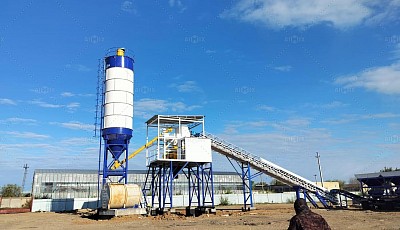Small Concrete Batch Plant
How Small Concrete Batch Plants Are Supporting Green Construction Goals
As sustainability takes center stage in the construction industry, equipment manufacturers and contractors alike are seeking ways to reduce environmental impact while maintaining efficiency. One of the most significant advancements in this area is the rise of small concrete batch plants and mini batching plants. These compact, efficient, and eco-friendly systems are playing a crucial role in supporting green construction goals around the world.
In this article, we’ll explore how small concrete batching solutions contribute to eco-conscious building practices and why more contractors are choosing them for sustainable development projects.
What Is a Small Concrete Batch Plant?
A small concrete batch plant is a compact version of a traditional batching plant designed for low to medium-scale concrete production. Ideal for urban construction sites, residential building projects, and remote locations, these plants occupy less space and require less energy to operate.
Closely related to this is the mini batching plant, which typically offers even smaller capacity and mobility for maximum flexibility. Both types prioritize reduced emissions, lower energy consumption, and minimal waste—making them ideal for green construction projects.
1. Lower Energy Consumption
One of the biggest environmental advantages of small concrete batch plants is their energy efficiency. Compared to large-scale facilities, these compact plants use smaller motors, mixers, and conveyors, which naturally consume less electricity or fuel.
Modern mini batching plants are often equipped with energy-saving features like variable frequency drives (VFDs), automatic shutdown systems, and efficient motor controls. This helps contractors reduce their carbon footprint without sacrificing performance.
2. Reduced Transportation Emissions
Large centralized batching plants often require concrete to be transported long distances, contributing to higher CO₂ emissions. In contrast, small concrete batch plants and mini batching plants can be installed directly at or near the construction site.
This on-site mixing minimizes the need for concrete delivery trucks, reducing fuel usage and traffic congestion. For projects in remote or environmentally sensitive areas, this is a game-changing advantage in meeting sustainability regulations.
3. Precise Material Management to Reduce Waste
Advanced control systems in modern mini batching plants allow for precise measurement of raw materials. This ensures optimal mix proportions, reducing the chances of batch rejection and material waste.
Additionally, small concrete batch plants offer the flexibility to mix only what is needed for a specific job, minimizing leftover concrete. Over time, this helps conserve natural resources like cement, sand, and water while lowering disposal costs.
4. Water Recycling Capabilities
Many small concrete batch plants now include integrated water recycling systems. These systems capture and reuse wash water from mixers and trucks, reducing water consumption and runoff.
For environmentally-conscious contractors, this feature aligns perfectly with green building certifications such as LEED (Leadership in Energy and Environmental Design). It also ensures compliance with environmental regulations, especially in regions facing water scarcity.
5. Compact Footprint and Minimal Site Disruption
Large-scale concrete plants require significant land, excavation, and infrastructure, which can disrupt ecosystems and local communities. In contrast, a mini batching plant or small concrete plant requires minimal space and can be set up quickly without heavy civil work.
This small footprint makes these plants ideal for urban environments and protected areas, supporting sustainable land use and reducing the environmental impact of construction operations.
6. Improved Mobility for Sustainable Project Management
Mobility is another important feature of small concrete batching solutions. A mini batching plant can be transported to multiple sites, eliminating the need to build separate permanent plants for short-term projects.
This flexible deployment strategy supports more efficient resource usage, especially in modular construction or infrastructure development across rural and underserved regions. It allows contractors to maximize plant utilization while reducing capital and energy investment for each project.
7. Supporting Eco-Friendly Construction Materials
Many small concrete batch plants are now being used in projects that incorporate green building materials, such as recycled aggregates, fly ash, slag cement, and low-carbon concrete mixes. These plants can be easily adapted to work with new materials, thanks to their customizable control systems.
As demand for sustainable construction materials grows, small and mini batching plants provide the agility to experiment with innovative mix designs that support long-term environmental goals.
8. Noise and Dust Control Features
Sustainability isn't just about carbon—it's also about creating safer, cleaner environments for workers and communities. Small concrete batch plants often come equipped with noise dampening systems, enclosed mixing units, and advanced dust collectors that minimize air and sound pollution.
This is especially important in residential and commercial zones, where reducing the environmental disturbance of construction is part of regulatory compliance and social responsibility.
Conclusion: A Smarter, Greener Future
As the construction industry continues to evolve, small concrete batch plants and mini batching plants are emerging as essential tools in the transition to greener, more sustainable building practices. Their compact size, energy-efficient design, and eco-friendly features make them a smart choice for contractors who are serious about reducing their environmental impact.
Whether you're working on a remote job site, building in a tight urban space, or managing a long-term infrastructure project, investing in a mini batching plant not only improves productivity but also helps you align with global green construction standards.

